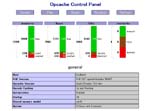On Dec. 24th, I enabled Opcache on my server (Windows7HP + SP1 (x86)).
Since installing “BulletProof Security“, it gave me a few trouble. On the other hand, it also brought me some useful information about PHP. For example, I saw its System Information page and changed values in my php.ini like the below. It’s for the security reason.
| Default | Custom |
| output_buffering = 4096 | output_buffering = Off |
| expose_php = On | expose_php = Off |
| mysql.allow_persistent = On | mysql.allow_persistent = Off |
The other day, I found the words “Opcode Cache” on the page. It reminded me of OPcache bundled with PHP5.5. Then I tried to enable it on my server.
I changed some settings in my php.ini.
First, I added the line “zend_extension=php_opcache.dll” to the end of Windows Extensions and changed the next six lines by following this page instructions. I can find better values for my server someday, but now, to follow the page instructions is better for me who is a very newbie of Opcache.
| Default | Custom |
| ;opcache.enable=0 | opcache.enable=1 |
| ;opcache.memory_consumption=64 | opcache.memory_consumption=128 |
| ;opcache.interned_strings_buffer=4 | opcache.interned_strings_buffer=8 |
| ;opcache.max_accelerated_files=2000 | opcache.max_accelerated_files=4000 |
| ;opcache.revalidate_freq=2 | opcache.revalidate_freq=60 |
| ;opcache.fast_shutdown=0 | opcache.fast_shutdown=1 |


I don’t use the CLI version of PHP, so I left “;opcache.enable_cli=0”.
On Apache benchmarks of before and after. ApacheBench
This benches show some improvements. But, with my feelings I realized more than the benches on the home network. I think Opcache brought major effects to my sites because most of them depend on PHP scripts, i.e. WordPress.
I had heard about APC Control Panel, so I looked for a Control Panel of Opcache and found. You can control Opcache from a Web browser by Opcache Control Panel, ocp.php. It requires the php function ‘phpinfo’, so you had better make an access control for this file.